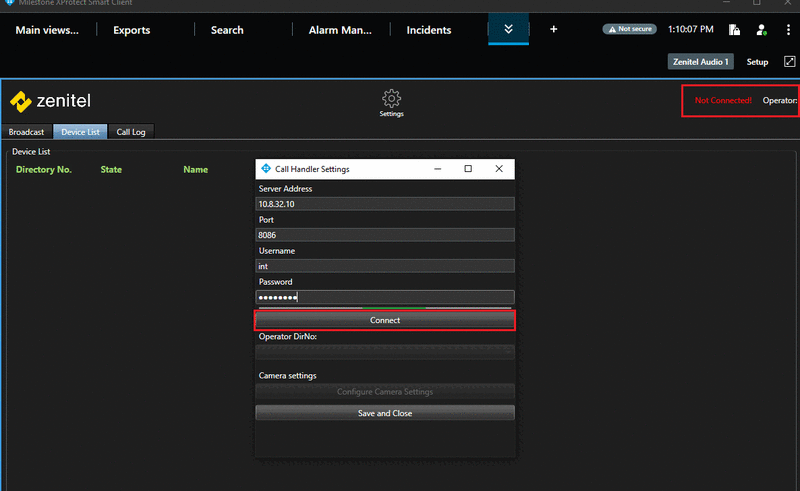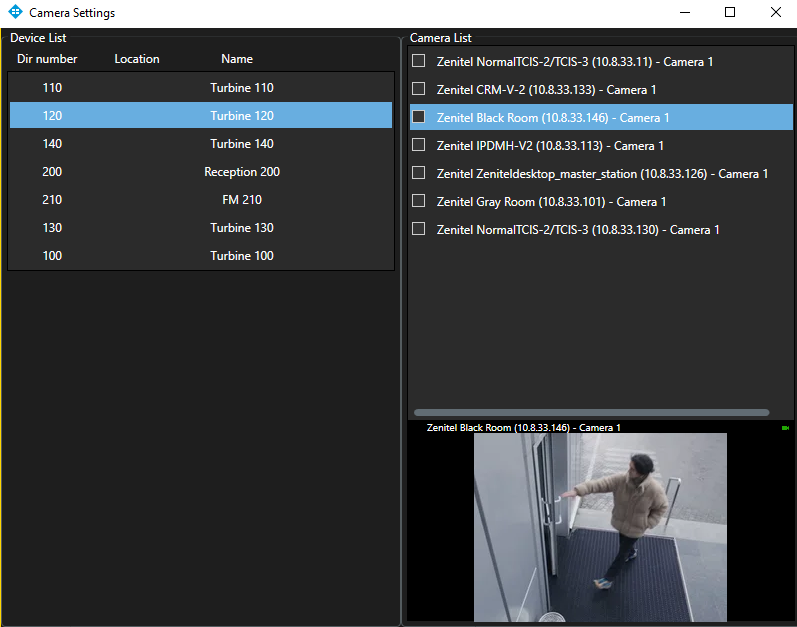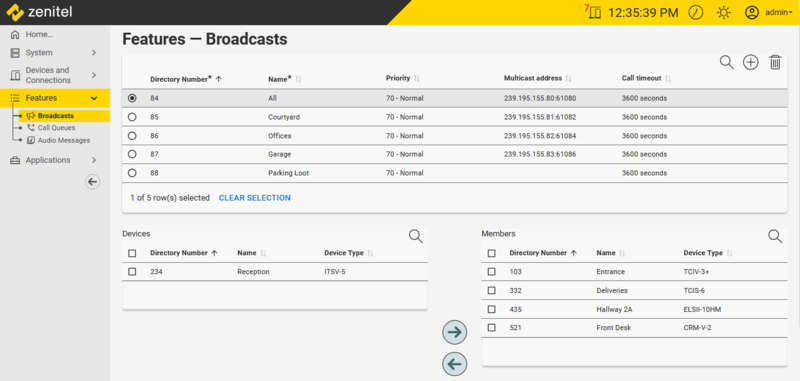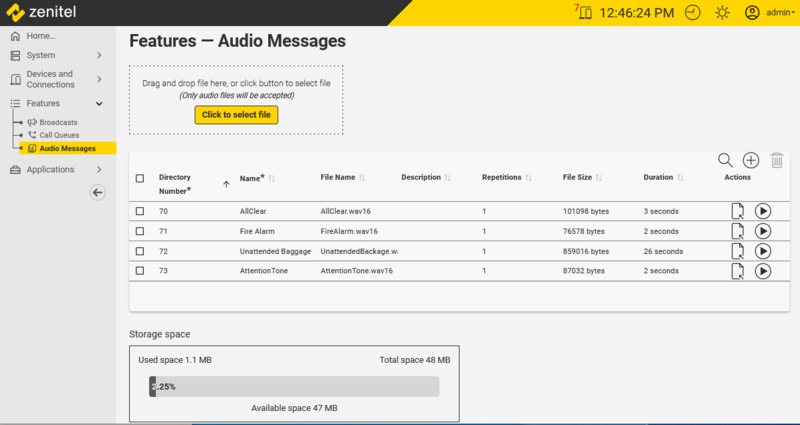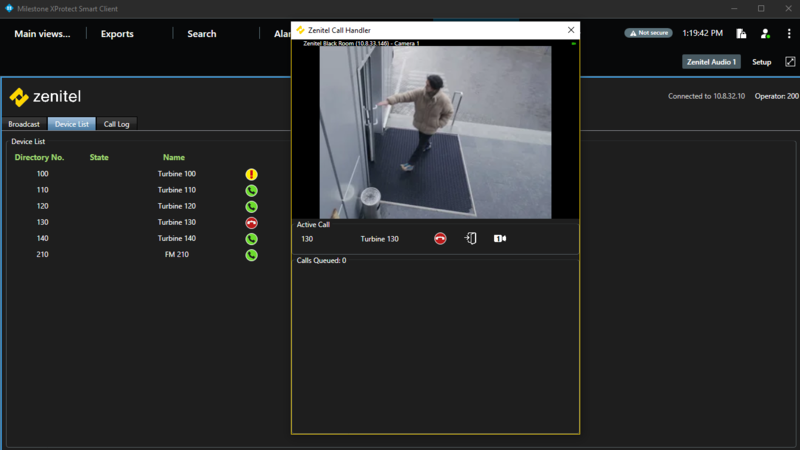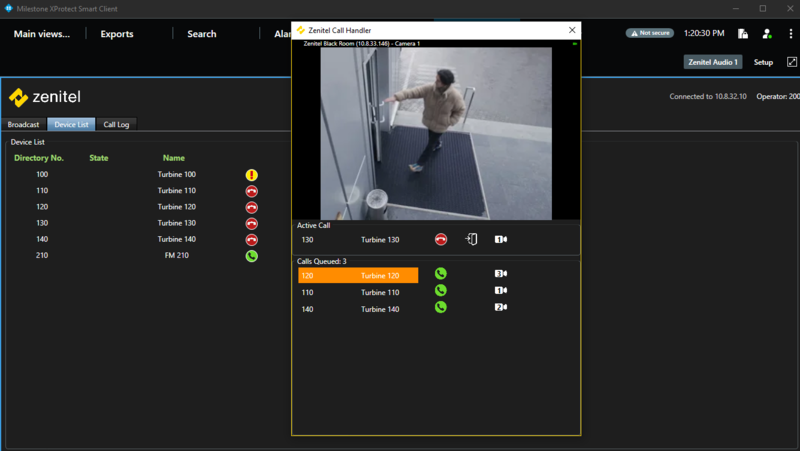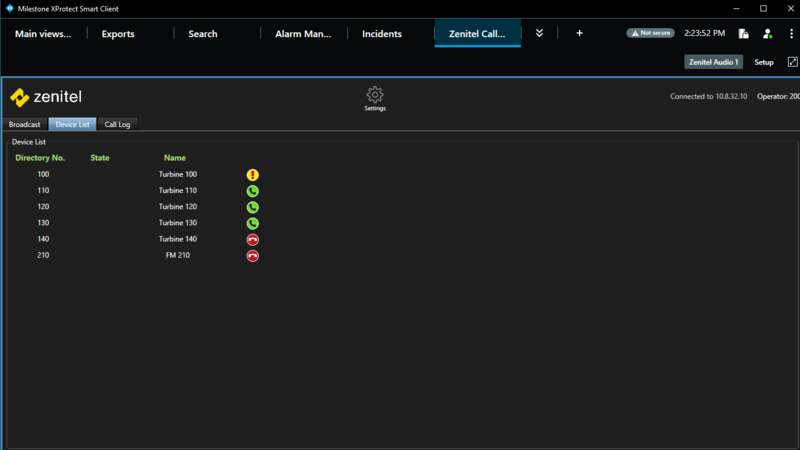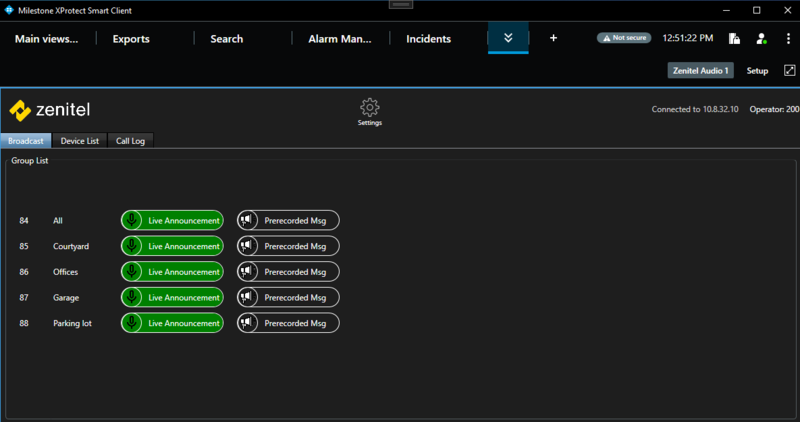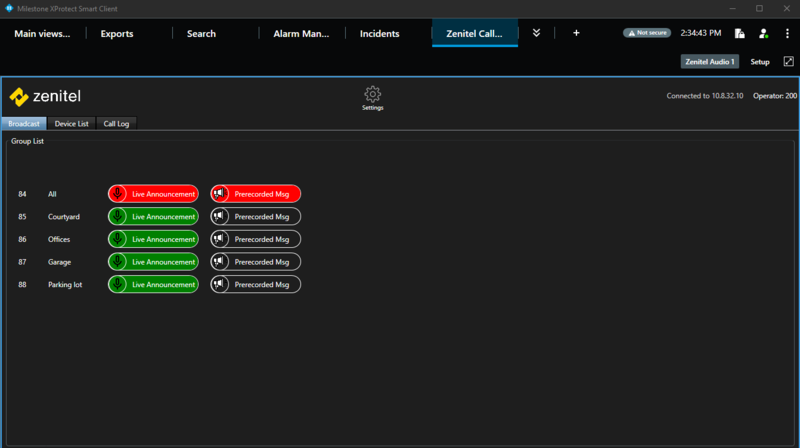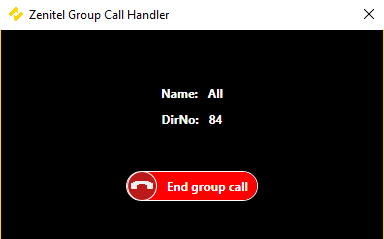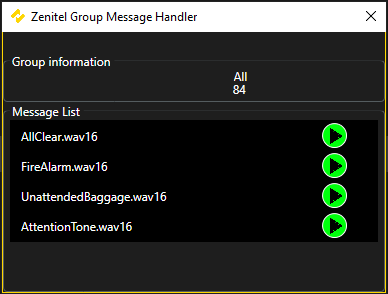Milestone XProtect - Zenitel Connect Pro Integration
From Zenitel Wiki
Introduction
The interface between Zenitel Connect Pro and Milestone XProtect is through an integration module.
This integration requires a Zenitel desktop station associated with each XProtect Smart Client, as audio is routed through Zenitel Connect Pro.
This article assumes that the reader is:
- familiar with the setup and operation of the Milestone XProtect VMS
- that Milestone XProtect is operational, with all the system connected and cameras configured
- that Zenitel Connect Pro is operational, with all the system connected intercom devices configured
Only points that are specific to this integration and to connected intercom stations and IP speakers are described.
Licensing
Milestone XProtect
The integration interface does not require a specific license from Milestone.
However, note that Zenitel stations are typically registered as ONVIF devices in XProtect, e.g. stream and record audio/video from stations. This requires separate station licenses from Milestone.
For an overview of the ONVIF features supported in Zenitel devices, please read our article ONVIF Settings
Zenitel Connect Pro
Zenitel Connect Pro requires an Integration license, item number 1002720900.
Installation
This section describes how to install the integration plugin.
It is assumed that the Milestone XProtect VMS is installed and running. It is also assumed that the Milestone XProtect VMS has been licensed appropriately.
- When installing (or uninstalling) the plugin all XProtect Clients (XProtect Management Client and XProtect Smart Client) must be closed.
- The plugin needs to be installed on the same machine as the XProtect Smart client.
- Download the MSI setup file from the Downloads section on Zenitel Wiki.
- Run the setup file, and follow the instructions on the screen
- When prompted for the installation location, select the Milestone/MIP installation folder (e.g. C:\Program Files\Milestone\MIPPlugins).
- Click "Close" to complete the installation.
Configuration
Basic plugin configuration
- Open the XProtect Smart Client.
- Open the "Settings" window by clicking the "Settings" Icon button in the toolbar.
- In the "Settings" window enter the IP address of your Zenitel intercom system in the "IP Address" field.
- The port used for connection is TCP port 8086 and must be open in the Zenitel Connect Pro firewall.
- The credentials used in the plugin are set in the Zenitel Connect Pro web interface with the role of a Zenitel Link User (not the administrator). See User configuration for more information.
- Click the "Connect" button and wait for the system to retrieve the list of available devices.
- Select the operator's device by choosing its directory number from the drop-down list.
Associating cameras with devices
- Open the camera settings window.
- On the left side, there will be a list of devices registered with Zenitel Connect Pro. On the right side, there will be a list of cameras registered within the XProtect system.
- Click on a device in the left list to select it.
- Click on an item in the right list to preview the video feed from that camera.
- To associate a camera with a selected device, click on the checkbox next to the camera's name.
- Repeat steps 3-5 to associate additional cameras with the selected device.
- Once satisfied with the configuration, close the camera settings window.
- Click "Save and Close" on the configuration window to save the changes.
User configuration
A user with the Zenitel Link User role must be added to the Zenitel Connect Pro. "Zenitel Link" is used for the communication between the Plug-In and the ZCP, and ensures authentication and authorization on the connection.
Broadcasting groups configuration
The broadcasting groups are set up through the Zenitel Connect Pro web interface. Users are required to establish groups and allocate devices to them within this interface. These configured groups will then be seamlessly integrated into the plugin, streamlining the broadcasting process.
Prerecorded messages configuration
Similarly, audio messages are uploaded within the web interface of Zenitel Connect Pro. This seamless integration ensures that audio communication is efficiently handled alongside broadcasting groups, providing users with a comprehensive platform for managing all aspects of their communication needs.
Using the Call Handler
The Zenitel Call Handler (Zenitel Connect Pro) plugin can be used for two scenarios: initiating calls and handling incoming calls.
Note that SIP audio is routed through Zenitel Connect Pro, so audio calls and audio broadcasts are established on a Zenitel desktop station.
If the Operator uses a desktop station, the Call Handler transfers the call from the Smart Client to the desktop station where the operator gets audio through the station connected handset, speaker, or headset.
Initiating Calls
In the XProtect Smart Client on the Zenitel Audio tab select a device you wish to call and click on the green "Answer/Call" button.
A popup window will be displayed showing the active call, along with a video preview from an associated camera.
Answering queued Calls
- When an inbound call is received, a popup window will be displayed showing the queued call, along with a video preview from an associated camera.
- To answer the call, click the green "Answer/Call" button.
- If there is an active call, the Call Handler will automatically hang up the active call and answer the inbound call.
- If there are multiple queued calls, they will be displayed in order of priority. To answer a specific queued call, simply click on the green "Answer/Call" button.
Tracking calls meant for a different operator
You can determine if a station is busy by checking the device list. If another operator has initiated a call, the current user will be informed about which operator and station are engaged. Notably, there will be no popup window displayed in this scenario.
Using the Popup Window
- The popup window displays the active call (if it was initiated by the operator) or a list of queued calls, along with a video preview from an associated camera.
- The popup window will display the camera feed from the first associated camera of the active call (if present) or if there are no active calls, the first queued device-associated camera will be displayed.
- To manually switch the camera video feed to any active or queued device, select the desired device from the dropdown list in the popup window.
- To hang up the active call, click the red "Hang-Up" button.
- To answer a queued call, click the green "Answer/Call" button.
- If there are multiple queued calls, they will be displayed in order of priority. To answer a specific queued call, select it from the dropdown list in the popup window.
Broadcasting
Live announcements
The user will be presented with a list of all available groups.
From this list, the user can make a selection to interact with a particular group by simply clicking either of the two buttons: "Live Announcement" or "Prerecorded Message."
Notably, if any group is currently engaged or busy, both buttons will be displayed in a distinctive red color to indicate the unavailability of the group.
This visual cue helps users quickly identify the status of the chosen group.
When the user clicks on the "Live Announcement" button, a new window will appear, providing the user with essential information about the selected group and the control to stop the Live Announcement Call.
Broadcasting prerecorded messages

|
Before using prerecorded messages, it's essential to upload WAV audio files to the Zenitel Connect Pro system. |
When the user clicks on the "Prerecorded Message" button, a new window will appear, providing the user with vital information about the selected group and controls for broadcasting prerecorded messages to that group.
How-To video
To learn more about this integration, please access the online training at Zenitel Academy via the link below (you must be part of Zenitel’s Learning Community Program. You can request to join the Learning community here).

